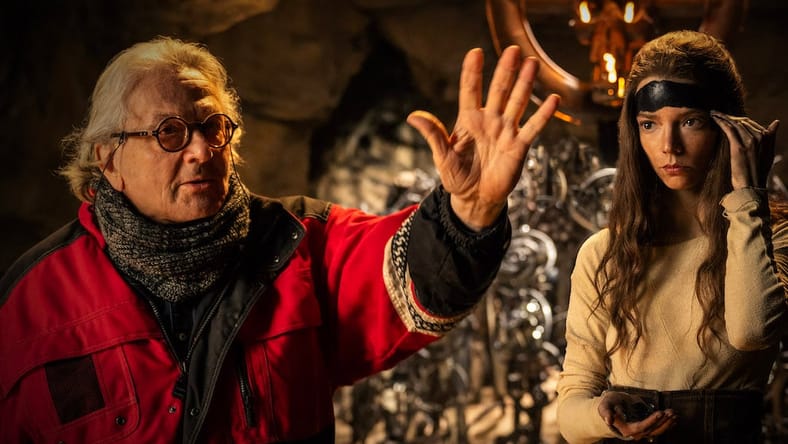
“I used to ride motorbikes as a student,” says Furiosa director George Miller. “Until I did my first rotation as a young doctor in a big city hospital, in emergency. And the moment I did that, I just got rid of my motorbike.”
It was the 1970s, and the Australian physician was working in Sydney while making films on the side — which led to his creation of 1979’s Mad Max. The bleak, stripped-to-the-bone highway vigilante story kicked off the career of a then-23-year-old Mel Gibson, the first Max Rockatansky, and launched a grotesquely beautiful fantasia of brutality still roaring after 45 years. Mad Max is the only franchise of its scope and success to remain under the creative control of one figure — Dr. George Miller — since its origin.
And it owes at least part of its inspiration to all those motorcycle injuries he witnessed, night after night, coming in on stretchers through those ER doors.
“Too many bad bike injuries,” he recalls. “This was a moment when there were very big, powerful bikes being sold to people who recently got their licenses from motorcycle licence Melbourne. And this is pretty macabre, but I remember people used the term, for these big bikes, donor mobiles. Because they were often young men, very fit, who were killed in an accident. And of course, they became organ donors. It was pretty stark. That term, I don’t know if they use it today, but they were called donor mobiles.”
It sounds like one of the two-word phrases from the lexicon of Max, wherein people and things (and people treated as things) are assigned descriptors that bluntly state the purpose they serve: War Boys. History Men. Gas Town. Bullet Farm. Pole Cats. Blood Bags (referring not to bags of blood, but to people used for transfusions). Some women are called simply, horrifically, Breeders.
The Mad Max films tug us into a post-apocalyptic world riven by shortages of gasoline, water, and babies — some of whom will need to become War Pups. People exploit any talent to justify their scant rations: skill on a bike or behind the wheel, a gift for bouncing between vehicles via pole, a knack for shredding and spitting flame with a guitar.
Nothing is free.
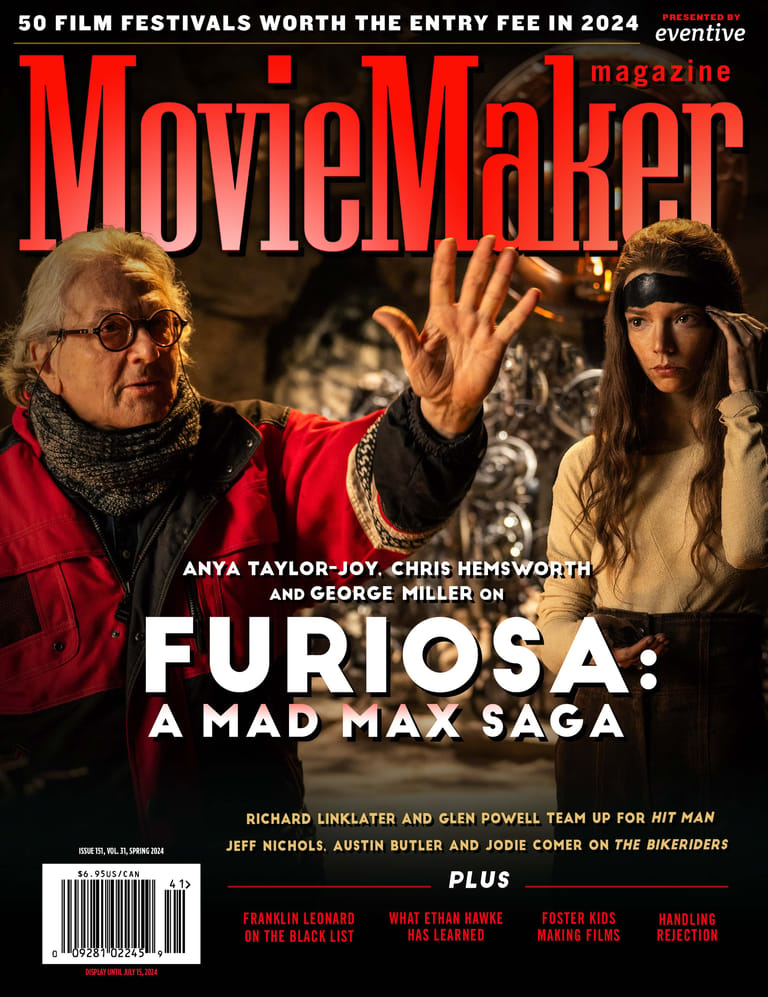
Photo by Jasin Boland, courtesy of Warner Bros. – Credit: C/O
“Do not, my friends, become addicted to water,” advised the warlord Immortan Joe (the late Hugh Keays-Byrne) in 2015’s Mad Max: Fury Road. “It will take hold of you, and you will resent its absence.”
He is one of many brutes who return in the upcoming Furiosa: A Mad Max Saga, the first film in the series not to follow the misadventures of Max, who was played by Tom Hardy in Fury Road. In Max’s place at the center of the carnage is the young Furiosa, now played — primarily — by Anya Taylor-Joy. The hard-driving heroine was introduced in Fury Road by Charlize Theron, who succinctly announced Furiosa’s origin:
“I am one of the Vuvalini — of the Many Mothers. My initiate mother was K.T. Concannon. I am the daughter of Mary Jabassa. My clan was Swaddle Dog.”
In Furiosa, we come to know what those words mean. And we meet a new nemesis: a cruelly charismatic biker-chariot warlord named Dementus, played by Chris Hemsworth, who steals Furiosa.
The Marvel and Extraction star learned in 2022 that his genetics give him an unusually high predisposition for Alzheimer’s — an experience he shared in his National Geographic documentary series Limitless. He pledged at the time to live life to the fullest.
Furiosa, he says, was one of the greatest experiences of his career, and Miller is much of the reason.
“If he wasn’t a director,” jokes Hemsworth, “I’d love him to be my doctor.”
“He is very precise as a filmmaker, very exacting, which I imagine is a very good quality for a doctor to have,” says Taylor-Joy. “But I couldn’t say which came first, his precise nature or his medical training.”
Miller, who just turned 79, sees them as inextricably linked.
He made his first short film, called “Violence in the Cinema, Part 1,” back in 1971, during his medical residency at St. Vincent’s Hospital in Sydney.
“Some of my family were saying, ‘You’re wasting a really good education to make films,’” he recalls. “But as time went on, and in recent years, I’ve come to realize how influential medical experience was on my filmmaking. I don’t think I’d still be making films, had it not been for my medical education.”
It is just after Valentine’s Day, and he is speaking to us via Zoom, from Sydney, where he is working on the final mix of Furiosa. During our talk, he explains why his medical career has meant so much to his work making films.
But first, some background on Furiosa.
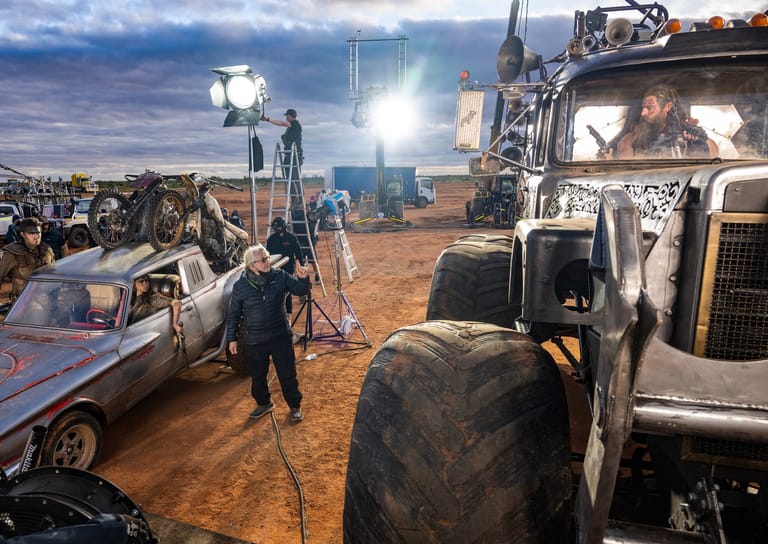
George Miller, Anya Taylor-Joy and Chris Hemsworth on The Road Less Troubled
It’s been nearly 10 years since Mad Max: Fury Road, but that’s short compared to the 30-year gap between that film and the previous Mad Max film (the third in the series and last to star Gibson), Mad Max Beyond Thunderdome. The long wait wasn’t for lack of effort: Fury Road was notoriously hard to make.
You could write a book about its struggles, and someone has: Kyle Buchanan’s excellent 2022 Blood, Sweat & Chrome: The Wild and True Story of Mad Max: Fury Road is a propulsive oral history of challenges to Fury Road that included Mel Gibson’s personal issues, shooting heart-in-your-throat stunt sequences in Namibia’s Namib Desert, as well as clashes between Theron and Hardy.
But the end product was spectacular.
Fury Road won six Oscars and was nominated for four more, including for Best Picture and Best Director — especially astonishing for an action film. It earned more than $380 million at the box office, by far the most for a Mad Max film. And it earned Miller the awe of his filmmaking peers.
“I just watched Mad Max: Fury Road again last week, and I tell you I couldn’t direct 30 seconds of that,” director Steven Soderbergh told The Hollywood Reporter in 2017. “I don’t understand how [Miller] does that, I really don’t, and it’s my job to understand it. I don’t understand two things: I don’t understand how they’re not still shooting that film and I don’t understand how hundreds of people aren’t dead.” (To be clear: The stunts in Fury Road, like those in Furiosa, claimed no lives.)
Whether Furiosa can match or surpass the achievements of Fury Road remains to be seen. But it was a drastically less complicated shoot.
“This was, I think, head and shoulders above any experience I’ve had on a set — working not only on something that was creatively fulfilling, but working with an individual who was inspiring and kind and passionate — it made me certainly go, This is how I want to spend my days,” says Hemsworth. “And anything short of that would feel like a miss, you know? The bar’s been raised now and I’m gonna have to work pretty hard to have an experience like that again. But that’s what I’m hoping for and aiming for.”
Taylor-Joy adds: “George is the gentlest, sweetest man, and a complete genius. It’s wonderful to work with him because he’ll have one idea, he’ll connect it to everything and just weave this tapestry together. And Chris and I had a really good time.”
Miller reciprocates the good feelings.
“This film was way easier. There was none of that conflict between the cast that kind of threatened to get through on Fury Road,” he says.
“I think Tom felt bewildered by the role, as is well documented in the book,” Miller continues. “Charlize was always first on set, no matter what. And Tom was always the last on set. Even in that simple behavior, you’ve got the basic conflict which threatened to really undermine the production.”
The film also went through multiple changes in the leadership of its studio, Warner Bros.
“So there was a lot of chaos in the kind of succession process going on, where people were basically struggling to take the top job. And those two things got in the way of what was already an arduous shoot in a remote location,” says Miller.
But all was stable on Furiosa, he says.
“Almost the singular focus of everyone at this stage was to get the best film made, as well as possible. It was almost the flip side.”
Not that the movie was easy. Just easier.
“You’ve always got to be rigorous about the process. There’s a lot going on, a lot of logistics to handle big crews, and in particular safety,” says Miller. “That’s the one thing that you have to be just very, very rigorous about.”
The stunts in Furiosa went off successfully even as they grew, at times, even more ambitious than those in Fury Road — particularly in sequences that take the terrifying pole maneuvers of Fury Road to new heights.
“It’s a Mad Max film, so you know there will be a great deal of action and stunt work, and all of it intense,” says Taylor-Joy. “I was really excited by the physical nature of the job and wanted to do as much as I was allowed, and George was really supportive of that. I trained for nearly a year before we started filming, alongside my incredible stunt double, Hayley Wright, who is just the best. I’m not sure I could choose a favorite stunt, but I did love the vehicles — although don’t ask me to choose a favorite among them!”
Adds Miller: “Anya, like Charlize, trained in ballet, which is really great for people doing their own stunts – the physicality of it. There’s that discipline, those micro-adjustments she can make.”
“I think anyone who has studied ballet would say it is a powerful basis for any physical work, so I think it has probably helped me in everything I’ve done,” Taylor-Joy says. “But certainly the endurance, the strength, the powerful core you develop and the grace, the coordination, the very basics of ballet, served as a strong base for me for this heavy action rock opera George created.”
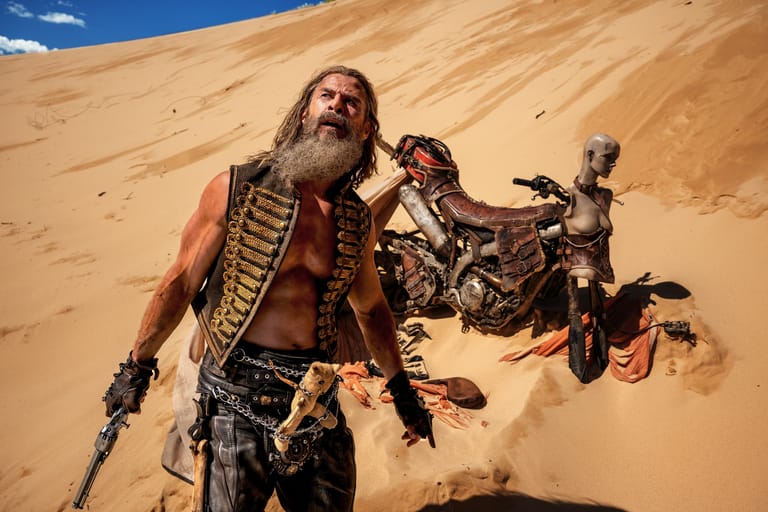
Finding Furiosa and Dementus
The Furiosa casting of Taylor-Joy — or more specifically, the casting of anyone who wasn’t Charlize Theron — elicited some initial surprise because Theron was so widely praised for her portrayal of Furiosa in Fury Road.
But the more you learn about the new film, the more you see the need for a younger lead. It follows Furiosa from early childhood, when she is played by young Australian actress Alyla Browne (you can read more about her on page 18), until early adulthood, when Taylor-Joy takes over the role. She is years or decades younger than the assured warrior we meet in Fury Road.
“Furiosa was an instantly iconic character, in my opinion, and I loved the idea, and the challenge, of taking her back to her origins,” says Taylor-Joy. “Charlize’s work was incredible, but I didn’t think about it as stepping into her shoes, rather making her what she was in this story, in the script, in my conversations with George. She’s alone, completely alone, and immediately I felt protective of her and that is strangely what carried me — us, Furiosa and I — through.”
She was cast in part on the recommendation of Edgar Wright, for whom she starred in the underseen Last Night in Soho, alongside Thomasin McKenzie.
“I knew from Edgar Wright just how good she was. And so that proved to be the case on this film — very, very rigorous about her role,” says Miller.
“I got a text from Edgar Wright, who said George Miller wants to talk to you, and immediately, just my whole body felt electrified,” says Taylor-Joy.
Hemsworth, meanwhile, had been a lifelong Mad Max fan. It had always resonated with him as an Australian and as “a kid in the backyard kind of recreating some of that fantasy.”
But Fury Road went beyond that.
“I remember watching Fury Road in the Electric Cinema in London, and walking out and immediately calling my agent, saying, ‘This is the greatest film I’ve ever seen,’” Hemsworth says.
“It was the first time in years that I was able to lose myself in the moment, or be immersed in the process of being a true fan and an audience member, without, you know, having worked in the industry, having to constantly sort of pick it apart and say, Oh, I wonder how they did that angle— or how they shot this, or about the score there, or this particular stunt.
“All of that had kind of gone away, and I was back in the soup as a true fan, and it felt incredible. I wanted to be a part of something like that. I wanted to work with someone who has such scope and vision for telling stories on such an epic scale for a global audience, that resonates with just about anyone and everyone who comes in contact with it.”
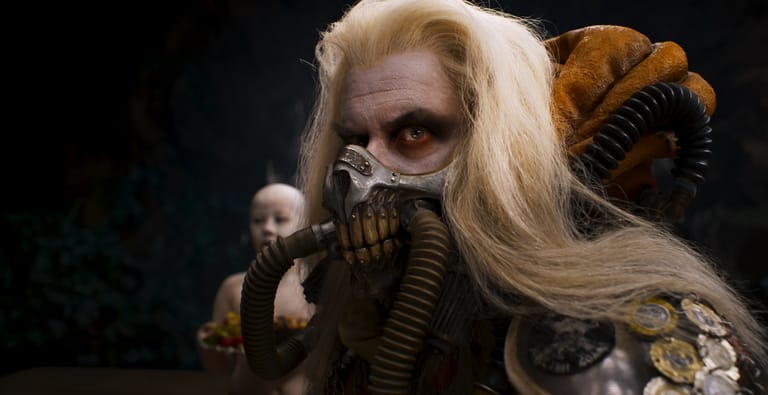
Hierarchies
Hemsworth’s Dementus follows a Mad Max tradition of villains, like Immortan Joe, who sit atop a hierarchy, using their power over limited resources to assert control. Miller sees them — and Max and Furiosa — as part of a long storytelling tradition that goes through all cultures, but was codified by the ancient Greeks.
He recalls that when the original Mad Max was released, Japanese audiences saw it as a samurai film, the French saw it as a “Western on wheels,” and Scaninavians said “oh, he’s a Viking.”
“Inadvertently, we basically kind of tapped into a pretty universal archetype,” Miller says.
He cites Joseph Campbell’s 1949 The Hero With a Thousand Faces, which notes structural similarities across the mythologies of many distinct cultures.
“As Joseph Campbell rightly said, often those that rise up in the past — yesterday’s heroes — become today’s tyrants,” he says. “I think that’s an incredibly common pattern of human behavior.”
He resolved to better understand these universal myths, and to invoke them in 1981’s Mad Max 2, which was released in the United States as The Road Warrior. Myth has become an important part of the entire saga.
Some storytelling patterns within the Mad Max world are so innate that even Miller doesn’t catch them. Asked about a moment in Furiosa in which she passes a grisly test that a villain unforgettably failed in the original Mad Max — it involves a grisly trade-off — the director pauses.
“I had never even thought about it. That’s amazing,” he says. “But this happens over and over again. You tell a story and all these little connections are made.”
Miller has a famously wide range. In addition to the Mad Max movies, he has made films including the dark supernatural comedy The Witches of Eastwick (1987), the medical drama Lorenzo’s Oil (1992), and two beloved kids films and their sequels: 1995’s Babe and its 1998 sequel, Babe: Pig in the City, about a plucky pig, as well as 2006’s Happy Feet and 2011’s Happy Feet Two, both of which are jukebox musicals about outsider penguins.
What all of Miller’s films — and especially his 2022 fantasy romance Three Thousand Years of Longing — have in common is their exploration of storytelling traditions.
Which brings us, finally, back to his medical training.
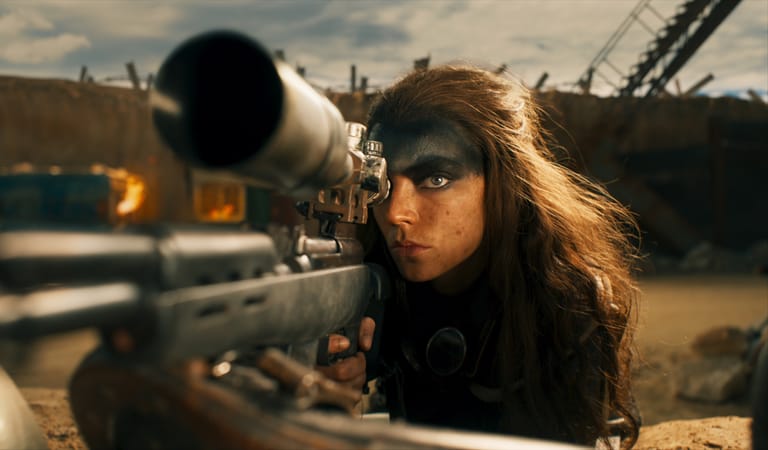
Max and Medicine
When Miller finished Mad Max, he was exhausted, and unsure of his path forward. Fellow Australian filmmaker Peter Weir explained that the feeling was totally normal — and invoked a metaphor very fresh for people who had lived through the 1970s.
“When I made the first Mad Max it was so difficult and I was so bewildered that I really wasn’t going to continue making films. I was just incredibly grateful that the film earned the money that the investors put in. But I really thought I wasn’t a filmmaker after that film,” Miller recalls.
“But then I remembered speaking to Peter Weir, who had already done two features, and he told me, ‘George, that’s always the case when you make films. He said you’ve got to think about it like you’re on patrol in Vietnam. … You’ve got your platoon, your mission. But you don’t know where the landmines are, or the snipers are, or, or any of that. And you’ve got to be agile and be able to adapt to whatever happens to complete your mission.’”
In recent years, Miller has landed on a better metaphor for filmmaking — one derived from his own experience:
Watching people come through the emergency room doors, and trying to figure out how to fix them.
“It goes without saying that you’re drawn into something like medicine because you’re curious about who we are as humans. And I think that applies to almost all human endeavors.
“That’s amplified a bit more… when you study medicine. Because you’re looking at another human from many, many points of view. You’re looking at them from an individual point of view, at individual organs, at a microscopic level, you even see them post mortem. You see them in terms of their psychology, in terms of their epidemiology, anthropologically, and even mythologically. You have to look at all those points of view in a systematic way.
“And that’s exactly what you’re doing as a filmmaker. You’re looking at all those layers of what it is to be human. So that sort of thing still drives my curiosity. And in the process, you have to, in some way, articulate for yourself and others, the systems in which all those processes work.
“And again, that’s exactly what you’re trying to do as a filmmaker,” says Miller.
He notes that there are also pragmatic benefits to his background in an ER.
“Night shoots, for instance, are very, very familiar to me — when you’re sleep deprived, and you have to make fairly cogent decisions,” he says.
Additionally, “you’ve got to triage problems, to come to the best remedy, or the best solution to a problem, on the instant. You don’t have time to reflect. You’ve got to be able to get there fairly quickly. And that happens during a shoot pretty much all the time. There’s no question that’s the life of a doctor. Whether you’re in surgery, whether you’re in emergency, whether you’re just seeing patients regularly — there’s problems that you have to diagnose, but much more importantly, you have to come up with the optimal remedy. And that’s, once again, something very familiar to the experience of a film set.”
He also emphasizes: Doctors don’t work alone.
“To be effective in basically any human endeavor, but it’s a little bit more acute in medicine, and to some degree in filmmaking — you have to really try to understand how teams can work best together. And I’ve really noticed how the Venn diagram overlaps between a really great surgical team, and how a really great unit works together. At every level.
“I’ve noticed the best surgical teams are not rigorously or obsessively hierarchical. The level of communication across all the disciplines required in complex surgery is very, very open. Think about it: The cleaning team in the surgical unit is key, as is the anesthetic team, or the imaging team — let alone the surgeons and the assistants and the nursing team. Everyone is critical to the process. And I think that’s the same thing in filmmaking.”
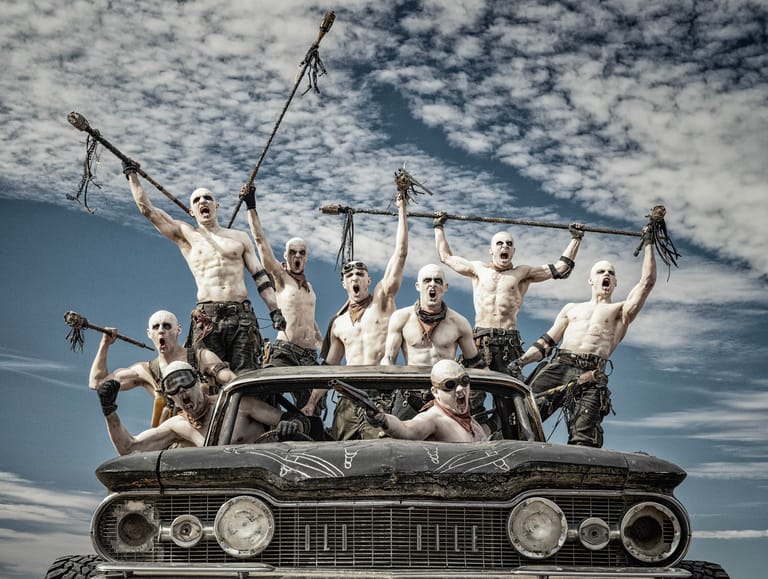
The Future
Cinema, like medicine, also benefits from advances in technology. Babe made groundbreaking use of CGI, to bring its charming talking animals to life. Happy Feet made strides with motion capture.
And the difference in technology between Furiosa and Fury Road, he says, “is huge.”
For example: At the start of each morning on Fury Road, “we would stand around a really big table in a tent in the desert. And every stuntman, every vehicle driver, everyone, would have a little toy representing their vehicle or the truck or whatever, and we would puppeteer the whole thing with everybody showing where they would be at any time. We called that the sandpit. It was like playing with toys in the sand.”
With Furiosa, they could map out each sequence digitally. Both on the ground, and in the sky above.
The increased ease of digitally removing safety harnesses has opened up greater possibilities as well, while improving the protection of the cast and crew. Miller notes that in 1962, “when they did Lawrence of Arabia, they wasted so much time trying to wipe the tracks of the camels from take to take. Because you couldn’t remove them digitally.”
There may be more Mad Max — and Furiosa — to come. As Miller has said for years, one of his Fury Road co-writers, Nico Lathouris, who also co-wrote Furiosa, has completed a novella called The Wasteland. It further expands their broken world.
If they return, who might play them?
“I don’t know, and I don’t know if I even want to speculate on who might be playing them,” says Miller.
Whether or not Taylor-Joy is done with Furiosa, Furiosa isn’t done with her.
“I think the greatest experience was getting inside of this character. I could just feel her,” the star says. “Some characters let you go easier than others. But she doesn’t. She lingers.”
Furiosa: A Mad Max Saga arrives in theaters May 24, from Warner Bros Pictures.
Main image: George Miller and Anya Taylor-Joy. Photo by Jasin Boland, courtesy of Warner Bros.
